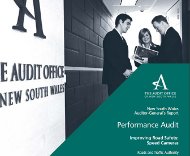8/9/2011
Australia: Speed Camera Deployments ExaminedAudit shows 72 percent of speed cameras in New South Wales, Australia showed no significant safety benefit.

The auditor general for New South Wales, Australia last month issued a report on speed camera use in the state. The Liberal Party government had ordered the review after it took power at the end of March. Following the results, thirty-eight camera locations have been taken offline.
As with the like-minded Conservative Party in the UK, NSW Liberals did not set out not to end the use of photo enforcement which generated 371,015 tickets worth $58,117,038 last year. Instead, the party's leaders are taking steps reduce the number of cameras and reverse the former Labor Party policies that kept safety, operational and revenue data for individual cameras a closely guarded secret. No effort had been made to evaluate the program since 2005.
Auditor-General Peter Achterstraat set out to answer whether speed cameras were located in areas identified as having greatest road safety risk and whether the number of crashes were reduced following their installation. Achterstraat pronounced the system a success.
"Overall speeding and crashes reduced after the introduction of fixed speed cameras," Achterstraat wrote. "The results are mixed when examining individual cameras, with crashes decreasing at some locations but not at others."
The audit's formal definition of a "successful" speed camera location included those places where there was no change in the number of accidents at all. The analysis found that 141 fixed speed camera locations, only 40 had statistically significant accident reductions, 38 had increases and 63 saw no significant change. This distribution of variation in crash rates is consistent with the assumption that cameras have no effect at all.
The audit looked at three years of data before and three years after, even though most of the cameras have been in place for at least eight years. In the US, the fatal accident rate has dropped significantly over time without significant speed camera use. According to the National Highway Traffic Safety Administration, there were 1.09 fatalities per 100 million vehicle miles traveled last year, down from the 1.13 fatality rate for 2009 -- the lowest rate since 1949. The rate was 1.73 in 1994.
Achterstraat noted that one out of five speed camera citations are issued to drivers exceeding the speed limit by 6 MPH or less for a $90 fine, but this did not mean that the cameras were set up to be a monetary trap. Seventy-three percent of tickets went to those accused of driving between 7 and 12 MPH over the limit for a $211 fine. The maximum speed camera fine in NSW is $1987.
"We found no evidence that potential revenue is a factor in decisions on where cameras are located," Achterstraat wrote. "Some [members of the public] sought to break the nexus between speeding and revenue-raising by suggesting abolishing monetary fines for speeding and replacing them with non-monetary sanctions.... All of these suggestions would impact on the revenue to government and therefore on the level of services that government could fund."


